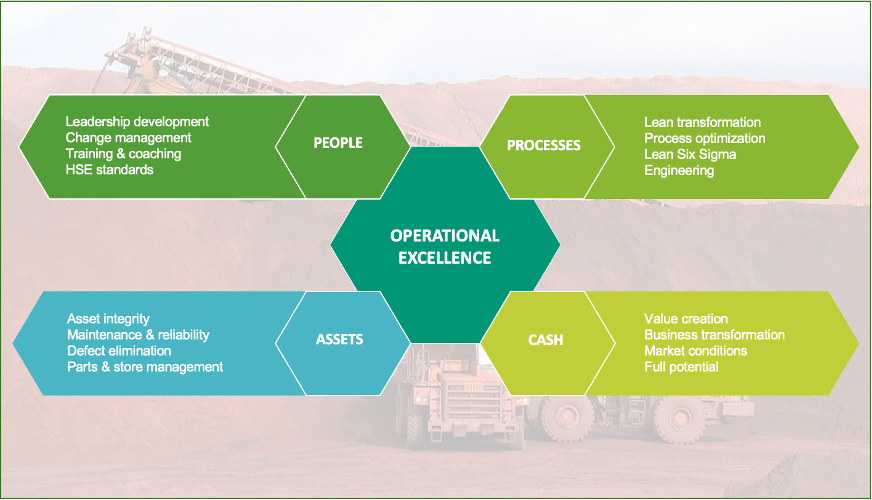The Mining Industry Has A Productivity Problem: The Need For “Operational Excellence”
Article first appeared in www.forbes.com. Here is the link to the original post.
According to a 2022 McKinsey study, the mining industry is not keeping up with other industries in terms of productivity. This presents a problem, but it also presents an opportunity for an industry critical to the energy transition.
Industries such as manufacturing and business services saw a steady improvement in productivity and efficiency over the last 25 years. However, the mining industry did not experience this same development, and productivity remained stagnant. In the study, McKinsey tracked companies in the manufacturing and business services industries, and the 10 largest saw their productivity index grow between 15% to 25% over the past 25 years, while the ten largest companies in the mining industry only saw growth of ~1% during the same period.
This is where operational excellence is needed to close the gap in productivity. Based on a continuous improvement mindset, operational excellence is a framework for striving for a consistent and efficient execution of business strategy, encompassing all aspects of production, safety and cost optimization to maximize productivity and profitability.
What is productivity, and why does it matter in mining?
In sports, productivity refers to a team's ability to organize its resources, players, time, strategies and coaching to win the game. A highly productive team knows how to harness all available resources together to achieve a goal, but they develop a process to produce these results through training.
In a mining context, productivity is more about efficiency of resources—such as labor, equipment, energy and time—to extract and process minerals. A productive mining operation minimizes waste, maximizes output and makes optimal use of known resources in the ground, all within a set budget, even amidst volatile market conditions.
Productivity is a competitive advantage for other industries, but from my experience, the mining industry is not paying attention. At least, not enough! With the challenges around social license to operate, ESG objectives and reputational risks of the mining industry, productivity is often only considered as an afterthought. The McKinsey study concluded that despite the short-term improvements in productivity and efficiency that mining companies can achieve, they continue to deal with the challenge of sustaining gains or keeping up with the pace of ongoing advancements.
It is for these reasons that I believe leaders in this industry must take steps to move beyond merely being productive and instead focus on pursuing true operational excellence.
What is operational excellence?
I define operational excellence as the overarching strategy that drives productivity in any organization, whether it's a sports team or a mining company. The value proposition of operational excellence is to increase business value safely and sustainably. It includes improving reliability and reducing risks and variations.
In mining and metals, I've witnessed firsthand the problem of chasing the flavor of the day. Complex operational excellence programs developed in the corporate offices rarely fit into the operating sites, which causes frustration with the front-line leadership. One of the first questions leaders should consider when developing an operational excellence program is, "Where are we, and where do we want to be?" Your business strategy and objectives should spell this out clearly.
Over the years, I have developed my own vision of operational excellence that stands on four pillars: people, processes, assets and cash. Every other practice and tool supporting operational excellence falls into one of these buckets.
• People
This pillar focuses on developing effective leaders, managing performance, redesigning organizations for efficiency and providing training and coaching to optimize the capabilities and well-being of the workforce, ultimately driving operational excellence through human capital.
• Processes
This pillar emphasizes the continuous improvement and optimization of operational processes, employing methodologies such as Lean, Six Sigma and engineering principles to enhance efficiency, eliminate waste and streamline workflows, resulting in improved productivity and quality.
• Assets
This pillar centers around maximizing the value and performance of physical assets through systematic optimization, asset management, reliable maintenance practices and efficient parts and warehouse management, ensuring optimal utilization and longevity of equipment and infrastructure.
• Cash
The cash pillar aims at creating value by strategically transforming the business. It focuses on marketing and sales initiatives and on leveraging the full potential of the organization to enhance profitability, generate sustainable revenue streams and effectively manage financial resources.
Overcoming Challenges
If you are planning to implement an operational excellence program or simply want to stabilize your processes, I have found that the most likely potential bottleneck is the team's capacity to execute and maintain the results. Getting the right things done at the right time in a sustainable way remains the challenge! Based on my experience with continuous improvement projects to support operational excellence, though, here are a few ways to avoid or overcome issues in this area.
• Ensure that the leadership team is aligned on and committed to the vision.
• Get the buy-in from your operators—frontline supervisors are key to success! Whether they are communicating the vision to their teams, aligning their work with the change goals, or addressing any concerns or resistance that may arise at the operational level, frontline leaders need to be empowered and enabled to act as change agents.
• Develop a clear roadmap with actionable and SMART goals. Focus on "what" and "how."
• Assign your A-team to the improvement program, especially for your pilot project.
• Maintain focus on value-added activities (unstick your team from the noise). It is the leader’s responsibility to prioritize goals and eliminate distractions from the objective of the program.
• Communicate clearly and frequently to all levels—this is key to change management. By ensuring that information is transparently and consistently shared, leaders can keep employees informed, address concerns and maintain alignment throughout the change process.
• Train your team, coach your leaders, reinforce the expectations and repeat.
Conclusion
Operational excellence, driven by a continuous improvement mindset, offers a framework to bridge this productivity gap in the mining industry. By focusing on the four pillars of people, processes, assets and cash, mining companies can drive operational excellence, increase productivity and achieve sustainable growth.


